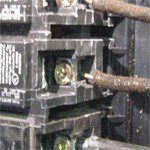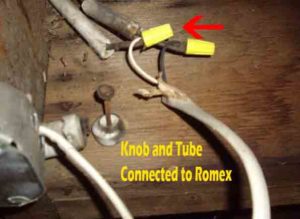Electrical Defects found during Home Inspection
Electrical Defects are common in homes that the home owner renovates himself. Except for new homes we always remove the Main Electrical Panel cover to examine the wiring for improper connections or double taps. Some of the interesting deficiencies we find are: double tap connections, too much insulation on cables inside panel, missing connectors, aluminum wiring or improper connections to bus bars etc. One item which is common with home owners doing electrical wiring is the lack of support or staples for cables. Current CEC rules state that only one cable per staple is permitted unless documentation from manufacturer allows more.
Common Electrical Inspection Defects
Many people power a piece of equipment or appliance using extension cords. Extension cords are only rated for use as temporary power supply and are not rated for use as permanent wiring, such as sump pumps, washing machines, garage door openers, gas ranges, and the list just goes on. If full time power is required then the appropriate outlet should be installed. Another item commonly found is romex electrical cable with a plug attached to the end. Romex cable is designed to be hard wired using approved boxes and protected from mechanical harm. Improperly installing an electrical product could cause circuit overloads, electrical shorts, and could cause a fire or shock hazard.
Main Electrical Panel Defects
Electrical panels are not permitted to be installed in bathrooms. Many times I have seen home owners build a bathroom around their electrical panel. This improper location of panel can be very difficult and expensive to fix. When purchasing a new home having it inspected by an experienced and knowledgeable home inspector can save you a lot of grief and money.
Size of Electrical Service
Most insurance companies will not insure a home unless it has a minimum of 100 amp service and main panel. Many times I have gone into an older home which had 100 amp on the Real Estate Listing only to discover that home had either a 50 or 60 amp main shut off. So when your line coming in is Restricted to say 60 amps, then no matter what size your panel board is you only have a 60 amp service. Missing this small item can cost you plenty for installing new service, mast, electrical permit and hydro shut down fees.
Aluminum Wiring
Everybody and their dog has an opinion on aluminum wiring installed in a home. The one item which you need to be aware of is that many insurance companies will not insure a home with aluminum wiring. I typically tell my clients to find out current insurer of home as they most likely will not have any issues with taking you on as a client. This could get complicated if your current insurance company will not insure and say you have a cottage insured with them also. Many insurance companies will not insure your  cottage unless you have your residence insured with them.
cottage unless you have your residence insured with them.
The main Electrical Defects of Aluminum wiring are known issues with corrosion and a phenomenon known as “Cold Creep”. When aluminum gets corroded the wire and connection can start arcing creating heat. The aluminum will tend to flow away from heat. So this increases gap which then increases heat generated by arcing, this can continue until it reaches point where fire may occur. Most aluminum wires that have been inspected will have an anti-oxidizing paste installed. Lack of anti-oxidizing paste inside a new panel board for instance would be an indication that panel was not installed by licensed electrician. Read article on Aluminum Wiring Inspections
There are a multitude of methods of reducing fire risk with aluminum wiring. Pig tail connections to copper wire in outlet boxes and switch boxes is one method. They actually have a designed connector for coupling copper and aluminum together. There are also approved Aluminum to Copper outlets and light switches. ( CO/ALR IS DESIGNATION OF THESE FIXTURES )
Knob & Tube Wiring
Century Type homes all had Knob and Tube electrical wiring at one time. Knob-and-tube wiring was run as individual wires—one black hot wire and one white neutral wire—throughout the home. The insulators keep the wires from touching each other and the  wood other combustible materials. To make connections and wire splices, electricians soldered the wires then wrapped them with a rubber electrical tape called friction tape. Over the years these homes have been renovated many times and usually the older knob and tube wiring has all been removed. Unfortunately in some cases the knob and tube is only removed in easily accessible places. Many times I have inspected one of this older homes and found live knob and tube circuits still in use. When purchasing a Century Home it is advisable to ensure your hiring an Experienced Century Home Inspector.
wood other combustible materials. To make connections and wire splices, electricians soldered the wires then wrapped them with a rubber electrical tape called friction tape. Over the years these homes have been renovated many times and usually the older knob and tube wiring has all been removed. Unfortunately in some cases the knob and tube is only removed in easily accessible places. Many times I have inspected one of this older homes and found live knob and tube circuits still in use. When purchasing a Century Home it is advisable to ensure your hiring an Experienced Century Home Inspector.
Two Wire with No Ground
Homes built in the 50’s to 60’s have older style two wire electrical cables with no ground installed. These older wires are grandfathered and do not have to be replaced. The only issue is the fact that there is no ground wire to safety remove any stray current that escapes from the wire. You have to remember when living in a house with older wiring that there’s no ground to protect appliances and sensitive electronics, leaving them vulnerable to damage from power surges. Check insulation for these cables to ensure there is no fraying or open cracks in protective material.
How a GFCI outlet works and why it is required.
Some Common Electrical Deficiencies Typically Found during Home Inspection
✅ Electrical junction boxes missing cover plates.
✅ Receptacles and light switches missing electrical cover plates.
✅ Electrical cables exposed to mechanical damage.
✅ Unsupported electrical cables.
✅ Reversed polarity on wall outlets.
✅ GFCI’s outlets improperly installed / fails to trip when tested
✅ Improper cable used for exterior installations
✅ Electrical connections made outside of electrical junction boxes
✅ Romex cable installed in metal stud walls improperly
✅ Unused electrical cables left hanging with exposed wires.
100% Money Back Guarantee
Read about the 100% Money Back Guarantee offered by Barrie Home Inspections.
Choose the right Type of Home Inspection for your needs. All Home Inspections with Barrie Home Inspections includes Free Thermal Imaging with Infrared Camera
Call Roger Frost for answers to any Home Inspection Questions or to Book A Home Inspection 705-795-8255